People often show me pictures they’ve taken of ghost pipes, proudly displaying their photographic fungal acumen. Imagine their surprise when I tell them that it’s actually not a mushroom, but a unique organism known as the “ghost plant”.
That’s right, a plant! I used to think they were mushrooms too. Yet these beautiful ghosts are actually perennial plants that lack chlorophyll, a feature that gives them their pale white color.
Although not a mushroom, I felt ghost pipes, aka indian pipes, deserved their own page to clear up some of the confusion about these crazy perennials. We’ll start with some basic ghost plant facts, and then look at some of their unique features such as how they feed themselves and why they’re cheaters.
Now you may be wondering how a plant with no chlorophyll survives. Read on to learn more!
Getting to Know the Ghost Plant
- Ghost pipes are very recognizable. In addition to their pale color, they have “flowers” on the top, small scaly leaves on the bottom, and usually grow between 4 and 10 inches tall.
- They always grow in shady woods directly on the ground. You won’t find them in sunny, grassy meadows or growing on the side of a live tree.
- Although known for their whitish color, if you look closer you’ll often see flecks of black or a pale pink cast. Some species even appear reddish or yellow.
Indian Ghost pipes pop up in temperate regions of Asia and the Americas. According to Wikipedia they’re considered rare in most places, although common in many parts of Eastern North America. (I live in NH and see them all the time).
- The Latin name of the most common species, Monotropa uniflora, means “once turned single flower”. Other much more fun names are ghost plant, corpse plant, and ice plant.
- As it doesn’t contain chlorophyll and doesn’t get its energy from the sun, the corpse plant can grow in very dark environments. This explains why you often find them in very dark or dense forests.
- While there’s only one Monotropa uniflora, people sometimes confuse it with Monotropa hypopitys. This plant, sometimes called the “Dutchman’s pipe”, is in the same genus and is usually yellow to red in color (right).
- Both Monotropa uniflora and Monotropa hypopitys are myco-heterotrophs, meaning they feed themselves by parasitizing certain types of fungi rather than through photosynthesis. Read on to learn more!
Ghost Pipes: Where’s Your Chlorophyll?
What’s a ghost plant to do when it contains no chlorophyll and gets very little sunlight? You steal energy from others! With this process:
A fungus wraps its mycelia around the roots of a tree in a mycorrhizal relationship.
- The tree gets more water and nutrients through the fungus.
- The fungus gets sugars produced by the tree.
- An indian pipe taps its roots into the mycelia of a fungus, allowing it to steal nutrients from both the fungus and the tree.
We were taught in school that all plants contain chlorophyll, a green pigment critical for photosynthesis. Photosynthesis is the chemical process that uses energy from sunlight to convert carbon dioxide into necessary sugars, allowing the plant to feed.
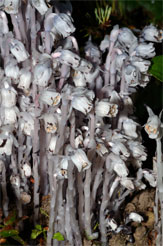
Very simply, with chlorophyll and sunlight a plant can produce what it needs to nourish itself.
Yet there are some glorious exceptions to this rule. Indian pipes are known as myco-heterotrophs, which are plants that get their food by parasitizing other fungi instead of through photosynthesis. It does this by linking its roots with the mycelia of a fungus.
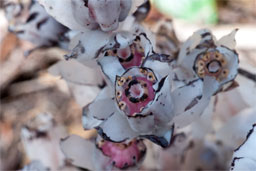
Once it’s connected to the underground threads of a fungus, it can interrupt the flow of nutrients and feed itself. It gives nothing back to the fungus in this exchange, and takes what it needs to survive.
In most cases, the fungus itself also has a mycorrhizal relationship with a tree. A mycorrhizal relationship is a beneficial exchange where mycelia of a fungus connects to the roots of a tree. The fungus gets access to nutrients such as sugars from the tree, and in return it widens the tree’s root system. This allows the tree to take in more water and nutrients.
Yet the ghost plant doesn’t parasitize just any mushroom. It prefers those from the Russulaceae family, which include the Russula and Lactarius genus. The next time you see these white plants be sure to look around the area. Do you see any Russula or Lactarius mushrooms nearby?
Myco-heterotrophs are sometimes called “mycorrhizal cheaters”, meaning they form what looks like a mycorrhizal relationship but give nothing back. In this case the indian pipe steals from both the plant and the tree. Making it, like your brother in law who raids your fridge and leaves nothing in return, a true parasite.
Learn more about myco-heterotrophs here.



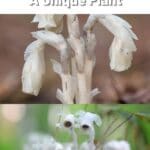
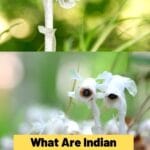
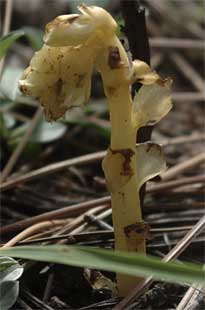 Indian Ghost pipes pop up in temperate regions of Asia and the Americas. According to Wikipedia they’re considered rare in most places, although common in many parts of Eastern North America. (I live in NH and see them all the time).
Indian Ghost pipes pop up in temperate regions of Asia and the Americas. According to Wikipedia they’re considered rare in most places, although common in many parts of Eastern North America. (I live in NH and see them all the time).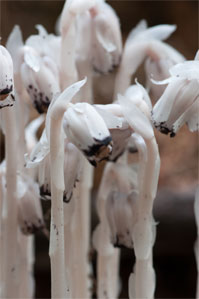 A fungus wraps its mycelia around the roots of a tree in a mycorrhizal relationship.
A fungus wraps its mycelia around the roots of a tree in a mycorrhizal relationship.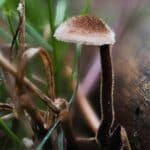
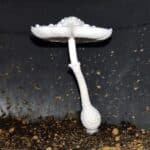
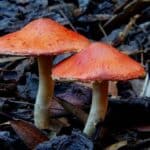
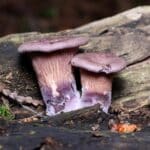
maxine
Thanks for the wonderfully thorough info. Do Indian pipes come in different colors? I’m not clear on the difference between Indian pipes and ghost pipes. Please explain more about latter.
Thanks,
maxine
Jenny
Indian pipe and ghost pipe are two common names to describe the same thing — Monotropa uniflora. They can be pinkish. If they’re yellow they’re dutchman’s pipe